Energy Markets Update
Weekly natural gas inventories
The U.S. Energy Information Administration reported last week that natural gas in storage increased by 16 Bcf. The five-year average injection for July is about 42 Bcf. Total U.S. natural gas in storage stood at 2,987 Bcf last week, 23.7% higher than last year and 13.1% higher than the five-year average.
US power & gas update
- Wholesale spot prices continue to settle lower than expected in most of North America, except for a few hot spots in the Southwest – namely Texas – where record heat has kept upward pressure on rates.
- Power rates from the Northeast across much of the Mid-Atlantic settled in the $25-35/MWh range for most of June and July, down roughly 65% year-over-year.
- We see tremendous value in open positions in the near term, perhaps even over the 12-18 months. Tenors beyond this will likely be impacted by tighter market conditions.
- Total natural gas in storage is ample at 2,987 Bcf, sitting 13.1% higher than the five-year average.
- Last week marked the hottest week of 2023 so far on a national level, as we saw the first bout of extreme summer temperatures across the Northeast and Mid-Atlantic and (yes, even more) triple-digit days in the Southwest.
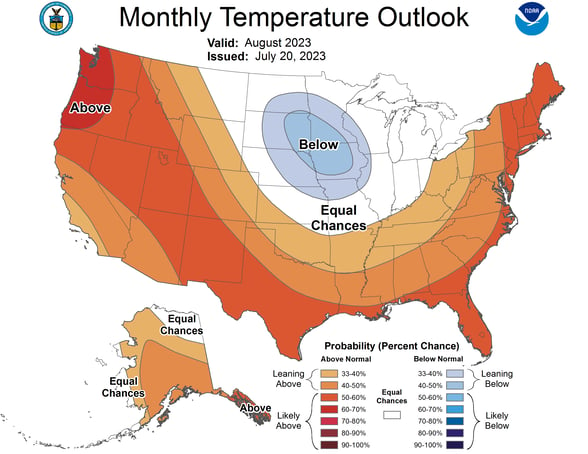 Source: NOAA
Source: NOAA- Given the heat, it’s no surprise that natural gas demand continues to set all-time records. However, production remains steady around 102 Bcf/d and little has changed to materially draw down the nation’s healthy gas storage position. Though, this could change if we continue seeing these hotter-than-normal temperatures.
- The nation’s largest grid operator PJM issued a Hot Weather Alert today and is asking for all available generation to remain on standby, including those previously on scheduled outages.
- Veolia is forecasting a high likelihood of peak load “PLC” events on Thursday and Friday for Northeast and Mid-Atlantic grid operators. Customers in PJM, NYISO, and ISO-NE are advised to curtail their afternoon energy usage on these days if possible.
Veolia PLC Forecast Alert
%20(1).png?width=708&height=630&name=PJM%20peak%20day%20risk%20(7.27)%20(1).png) Source: Veolia
Source: Veolia
- Despite temperatures exceeding 100°F in much of Texas last week, the grid has and prices have remained markedly stable, in part due to strong output from renewables.
- Offshore wind was dealt a painful blow over the past couple of weeks with 2 major projects being canceled: Commonwealth Wind in Massachusetts and Revolution Wind 2 in Rhode Island. Officials have vowed to find replacements but this puts New England in a challenging spot given the large bets on the fledgling industry.
- Average monthly Henry Hub spot prices (the benchmark for NYMEX contracts in the U.S.) have fallen 34% since January of this year. Analysts expect prices to take a bullish turn in 2024 and onward as US LNG exports increase and the storage surplus finally starts to dwindle.
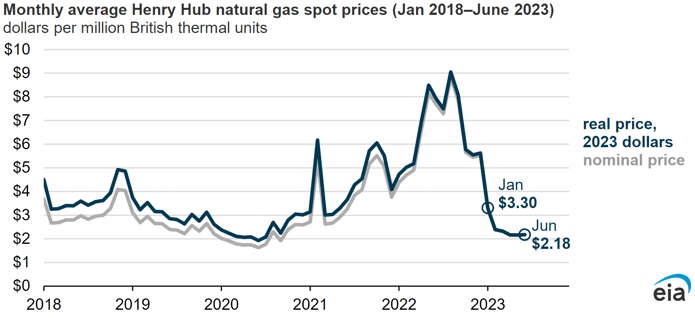
Source: EIA
NY regulators adopt 3-year rate plan for ConEdison's electric, gas operations
- On July 20, The New York Public Service Commission adopted a three year joint proposal for ConEdison’s electric and gas operations covering the period from Jan 1, 2023 until Dec 31, 2025.
- ConEd's initial proposal has been reworked and authorized by New York regulators to implement three-step base rate increases for both electricity and gas.
- The joint proposal will equate to electric delivery rates increasing 4.2% in 2023, 4% in 2024 and 3.8% in 2025. Gas delivery will increase by about 6.7% this year, 6.3% in 2024 and 5.9% in 2025.
- As we reported earlier this year, ConEd requested a “make whole” provision to make up for the extension of the suspension period in these proceedings from Jan 1, 2023, and it has been approved.
- As a result of this “make whole” provision, rate payers will have to make up for unfulfilled payments during the approval process, seeing even further increases on energy bills in the coming months.
- Looking forward, ConEd is also looking into increasing rates for steam. While not yet approved, according to their proposal, they intend to begin steam rate increases on November 1, 2023.
- Veolia’s Energy Market Analysts are available if you have any questions about adjusting budget forecasts for the balance of this year or next.
Renewables outperform during Texas heatwave
- In our last blog, we reported that an extreme heatwave was causing record-breaking cooling demand in the southern US. The saga continues as Texas braces for more triple digit temperatures this week.
- The question is: how much longer will this heat persist and can ERCOT, the grid operator, maintain reliability under a prolonged heat wave scenario?
- Unfortunately, cooling relief will not come anytime soon as Texas is currently stuck under a “heat dome,” where the atmosphere is trapping hot ocean air over the region like a lid. Heat domes trap sinking warm air on the ground, causing the surface to warm. They also bring cloudless skies, where sunlight heats the surface even more. Heat domes have become increasingly common due to climate change.
- ERCOT has already surpassed its peak load record 10x in the last month.
- On the bright side, renewable power has helped to keep prices down and maintain reliability thus far, despite some notable forced outages at thermal plants earlier in July. During a similar heatwave in August 2019, day-ahead wholesale electricity prices in ERCOT’s Houston zone surpassed $500/MWh on many days. Comparatively, the average day-ahead price during this year’s heatwave was $79/MWh.
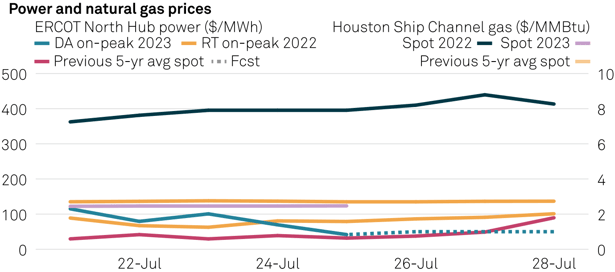
Source: S&P
- On June 28th, Texas set a record for electricity generation from renewable sources, peaking at 31 GW. Renewables provided between 35 and 40 percent of Texas’s power during peak periods. Renewables also mitigated electric price volatility, keeping wholesale energy below $63/MWh on July 18th, despite record demand (108F in Dallas!)
- A report from the University of Texas at Austin estimates that renewables have saved the average Texas household $200 per year in electricity costs over the last five years. Renewables are generally "price takers" in the energy market, meaning that they work to displace the need to more expensive thermal generation and marginally reduce prices in the energy market.
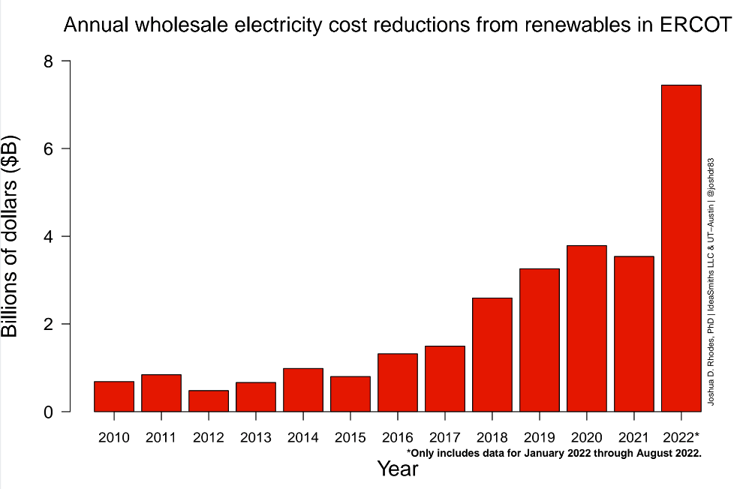
Source: Utility Dive
- Challenges facing the renewables industry in Texas are the need for transmission buildout to avoid congestion, hostile political attitudes towards renewables, and a general and growing uneasiness with relying so heavily on intermittent resources during critical hours. In the wake of a 2021 winter storm that left most of the state without power, the state could also benefit from infrastructure winterization efforts.
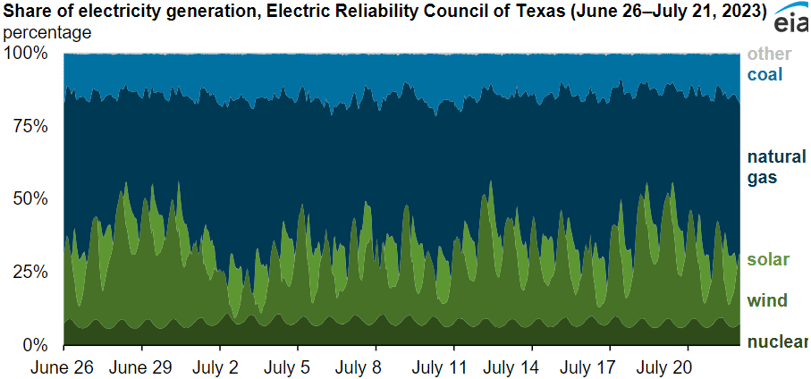
Source: EIA
PJM warns of future reliability problems, but takes steps toward improving interconnection queue
- Earlier this year, PJM rang the alarm bell on grid reliability as increasing electricity demand coupled with thermal generation retirements running ahead of new resource additions has created “reliability risks.”
- ~40 GW of PJM’s installed capacity is at risk of retirement by 2030, and PJM’s interconnection queue of new projects, largely solar and hybrid energy storage, may have trouble filling the gaps. Solar capacity for instance has a historical completion rate of about 5%.
- PJM officials warned that the operator’s current reserve margin (unused available capacity of the grid) is approximately 22%, but could fall below 14% absent a quick turnaround of new power generation coming online.
- The grid operator expects demand growth of 1.4% annually over the next decade, with certain load zones experiencing demand growth as high as 7% annually.
- This week, PJM stakeholders propelled these concerns back into the spotlight after asking the grid operator to address questions on demand response and public appeals for curtailing power demand, among others.
- Not everyone agrees with PJM's concerns. For example, economist James Wilson stated that the grid operator has sufficient tools to address its resource and reliability challenges.
- PJM’s capacity market, the Reliability Pricing Model (RPM), ensures long-term grid reliability by procuring adequate resources to meet future energy demand. PJM’s ‘pay-for-performance’ model requires resources to deliver on-demand during grid emergencies, or (literally) pay the price for underperforming.
- Wilson believes PJM’s analysis did not incorporate the RPM, which uses a slope demand curve meaning for reserve margins to decline, capacity prices have to increase significantly. However, for the third consecutive year, the clearing price for the majority of PJM’s footprint fell (see below).
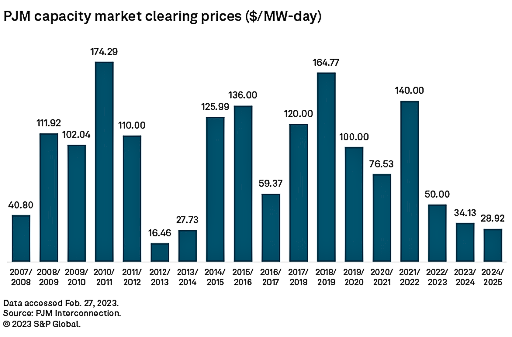 Source: S&P
Source: S&P
- While PJM’s analysis also raises concerns about a logjam of renewable projects, on July 10th PJM officially launched its transition to a “first-ready, first served” clustered cycle approach to process requests from developers. This is a major development that could free up GWs of stalled out projects.
- More than 260,000 MW in proposed generating capacity is projected to be cleared by 2027 — about 62,000 MW in ‘24, another 100,000 MW in ‘25, and an additional 100,000 MW in ‘26. More than 95% of those projects represent renewable energy, battery storage or a hybrid of both.
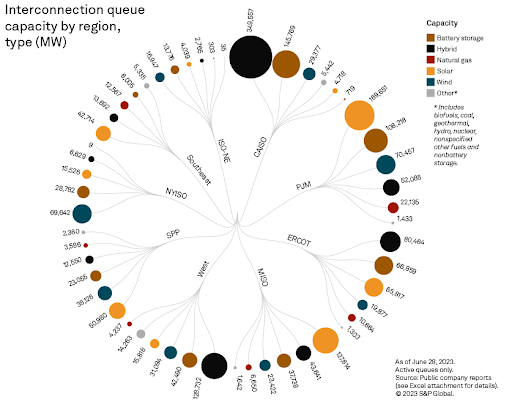
Source: S&P
- PJM is also seeking capacity market (RPM) reforms to address system reliability during the region’s energy transition. At a June 15 capacity market forum in Washington, DC PJM proposed a seasonal capacity market design that would be split between summer and winter.
- All said, PJM is objectively in a less vulnerable position than some other RTOs given its size, resource availability, and the fact that it is not so reliant on just a few major assets--the coutnerpoint being New England.
Biden-Harris administration approves big bucks for grid resilience, solar, & green jobs
- Over the past two months the Biden-Harris administration has announced over $1 billion aimed towards grid resilience, optimizing solar panel lifecycles, and increasing the number of jobs in the green energy sector.
- One June 20, 2023 the administration announced they would be allocating $975 million of Inflation Reduction Act (IRA) funding to emerging green energy technologies in federal buildings while simultaneously creating jobs.
- This investment along with others used through the US General Services Administration (GSA) is expected to avoid 2.3 million metric tons of greenhouse gas emissions and reduce power consumption by enough to power more than 300,000 US homes.
- The funds from the IRA will be used to improve about 20% of the GSA’s federal buildings, which amounts to about 40 million square feet.
- The GSA envisions these funds will be used to maximize greenhouse gas reductions through direct investments in technologies, including heat pumps, electrification, lighting retrofits and more.
- On July 20, 2023, the US Department of Energy (DOE) announced that they were awarding about $30 million in funding to a variety of groups aimed to improve grid resiliency.
- There are three states, three tribal nations, and one Alaskan Native Corporation that will receive this funding. The states are Connecticut, Ohio, and Vermont, and the other recipients are the Middletown Rancheria of Pomo Indians of California, Cook Inlet Region Inc., The Muscogee (Creek) Nation, and the Village of Dot Lake.
- This is the fourth wave of grants issued by the DOE out of a pool of $2.3 billion to be issued over the next five years.
- On July 21, 2023, the DOE announced a $20 million investment to improve the lifecycle of solar energy systems.
- This funding is aimed to minimize the amount of material needed in these systems, improve the effort needed for installation and maintenance of these systems, and increase the amount of these materials that are recycled or reused at the end of their life.
- The goal of this funding is to not only improve the lifecycle of solar, but also to help accelerate the growth of the solar industry in the US.
Natural Gas Storage Data
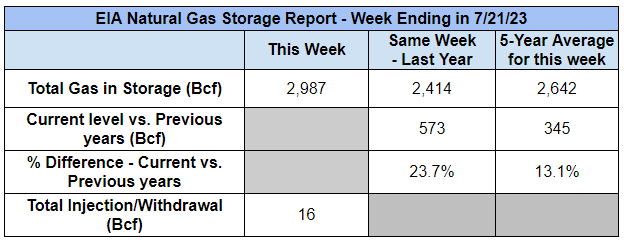
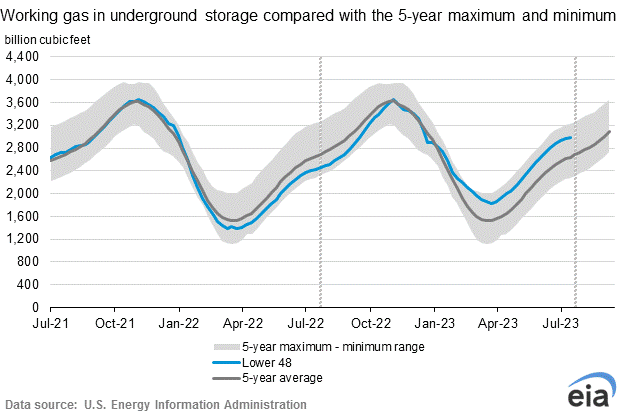
Market Data
Market data disclaimer: Data provided in the "Market Data" section is for the newsletter recipient only, and should not be shared with outside parties.



